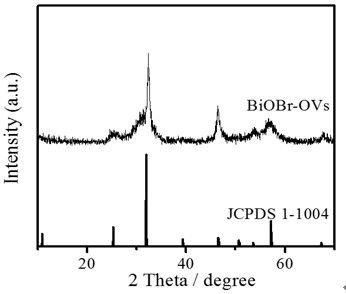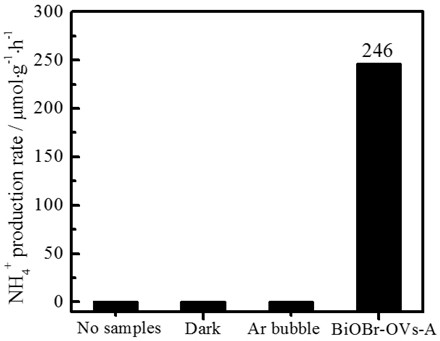Synthesis and application method of BiOBr photocatalyst containing light-controlled oxygen vacancy
A photocatalyst and synthesis method technology, applied in the field of nanomaterials, can solve the problems of poor photocatalyst stability, single performance composition, etc., and achieve the effects of easy industrial production, cheap and easily available raw materials, and stable performance.
- Summary
- Abstract
- Description
- Claims
- Application Information
AI Technical Summary
Problems solved by technology
Method used
Image
Examples
Embodiment 1
[0031] 0.01molBi(NO 3 ) 3 ·5H 2 O was added to 50 mL diethylene glycol and stirred at room temperature for 1.5 h, and 0.01 mol NaBrO 3 Add it into 50mL of distilled water and stir at room temperature for 1.5h, mix the two solutions, and react continuously for 3h under this condition until a precipitate is formed, and finally separate, wash and dry the obtained precipitate to obtain the light-controlled oxygen The vacant BiOBr is denoted as BiOBr-OVs-A.
[0032] The obtained BiOBr nanomaterials containing photocontrolled oxygen vacancies were used for photocatalytic nitrogen fixation reaction. The reaction conditions are: normal temperature and pressure, the amount of catalyst used is 0.05 g, the amount of water used is 100 mL, the light source used is a xenon lamp, the power is 300 W, the illumination is 120klx, the distance from the reaction interface is 20 cm, and the wavelength of the emitted light is 200-800 nm simulated sunlight. Specific operation steps: First, diss...
Embodiment 2
[0034] 0.01mol Bi(NO 3 ) 3 ·5H 2 O was added to 50 mL diethylene glycol and stirred at room temperature for 2 h, and 0.01 mol NaBrO 3 Add it into 40mL distilled water and stir at room temperature for 2 hours, mix the two solutions, use a water bath to control the temperature at 4°C, and continue to react under this condition for 3 hours until a precipitate is formed, and finally the obtained precipitate is separated, washed and dried. The BiOBr containing photo-controlled oxygen vacancies can be obtained, which is denoted as BiOBr-OVs-B.
[0035]The obtained BiOBr nanomaterials containing photocontrolled oxygen vacancies were used for photocatalytic nitrogen fixation reaction. The reaction conditions are: normal temperature and pressure, the amount of catalyst used is 0.05 g, the amount of water used is 100 mL, the light source used is a xenon lamp, the power is 300 W, the illumination is 120klx, the distance from the reaction interface is 20 cm, and the wavelength of the e...
Embodiment 3
[0037] The BiOBr-OVs-A nanomaterial containing photo-controlled oxygen vacancies obtained in Example 1 was used in the photocatalytic nitrogen fixation cycle reaction to test its stability. The reaction conditions are: normal temperature and pressure, the amount of catalyst used is 0.05 g, the amount of water used is 100 mL, the light source used is a xenon lamp, the power is 300 W, the illuminance is 120 klx, the distance from the reaction interface is 20 cm, and the wavelength of the emitted light is 200-800 nm simulated sunlight. Specific operation steps: First, put the photocatalyst in water, ultrasonically dissolve it fully, and then pass nitrogen gas for 0.5 h under the condition of avoiding light, in order to completely exclude the air; then turn on the light source, conduct photocatalytic nitrogen fixation experiment, after 1 h of light, Test its nitrogen fixation activity, and then continue to test its activity after the recovery of the catalyst containing oxygen vaca...
PUM
 Login to View More
Login to View More Abstract
Description
Claims
Application Information
 Login to View More
Login to View More - R&D
- Intellectual Property
- Life Sciences
- Materials
- Tech Scout
- Unparalleled Data Quality
- Higher Quality Content
- 60% Fewer Hallucinations
Browse by: Latest US Patents, China's latest patents, Technical Efficacy Thesaurus, Application Domain, Technology Topic, Popular Technical Reports.
© 2025 PatSnap. All rights reserved.Legal|Privacy policy|Modern Slavery Act Transparency Statement|Sitemap|About US| Contact US: help@patsnap.com



